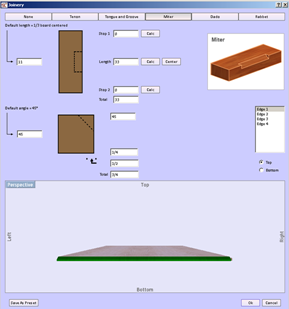Joinery is used to construct your cabinet design.

Cabinet joinery refers to the various methods and techniques used to join pieces of wood together to create cabinets. It’s a fundamental aspect of woodworking that requires precision and skill to ensure strong, durable, and aesthetically pleasing cabinets. Let’s dive into some of the most common types of cabinet joinery and their uses.
Butt Joint
One of the simplest types of joinery is the butt joint. It involves two pieces of wood joined by simply butting them together at a right angle. Often reinforced with screws, nails, or glue to provide additional strength. This joint is commonly used for simple projects where high strength isn’t required.
Dado Joint
The dado joint involves cutting a groove into one piece of wood that matches the edge of another piece. This fits them together snugly. Stronger than a butt joint, it provides more surface area for the glue to adhere to. Dado joints are often used in cabinet and bookshelf construction because they provide a solid, stable connection.
Rabbet Joint
Similar to the dado joint, a rabbet joint involves cutting a groove or notch along the edge of a piece of wood. This allows another piece to fit into the notch, creating a robust and flush connection. Often used for the backs of cabinets and drawers, they provide a clean, strong edge.
Miter Joint
A miter joint is formed by cutting the ends of two pieces of wood at a 45-degree angle and joining them to form a right angle. This type of joint is often used for picture frames and decorative trim because it provides a clean, seamless appearance. While it looks nice, it’s not as strong as other joints and usually needs reinforcement with nails or glue.
Mortise and Tenon Joint
The mortise and tenon joint — one of the oldest and strongest joinery techniques. It involves cutting a square or rectangular hole (mortise) into one piece of wood and a matching projection (tenon) on the end of another piece. The tenon fits snugly into the mortise, creating a strong, stable joint. This method employs often in high-quality cabinet and furniture making because of its durability and strength.
Tongue and Groove Joint
The tongue and groove joint involves cutting a tongue on one piece of wood and a matching groove on another. These pieces fit together snugly, creating a strong, stable connection. This type of joinery is often used for flooring, paneling, and cabinet backs because it provides a smooth, seamless appearance.
Dovetail Joint
The dovetail joint is known for its strength and resistance to pulling apart. It involves cutting a series of interlocking “tails” and “pins” on the ends of two pieces of wood. These pieces fit together like a puzzle, creating a very strong connection. Dovetail joints are often used in drawer construction because they can withstand a lot of stress and movement.
Box Joint
Similar to the dovetail joint, the box joint (or finger joint) involves cutting a series of interlocking notches on the ends of two pieces of wood. These notches fit together, creating a robust and durable connection. Box joints are often used in cabinet and drawer construction because they provide a lot of surface area for glue, making them very strong.
Biscuit Joint
To create a biscuit joint, cut a small slot into the edges of two pieces of wood and insert a small, oval-shaped piece of wood (biscuit) into the slots. Glue and clamp the pieces together, allowing the biscuit to swell, which creates a strong, stable connection. Woodworkers often use this type of joinery for cabinet construction and furniture making because it’s quick, easy and provides a strong bond.
Pocket Hole Joint
The pocket hole joint involves drilling a hole at an angle into one piece of wood and screwing it into another piece. This method is quick, easy, and provides a strong connection. Pocket hole joinery — often used in cabinet and furniture construction because it’s simple and effective. Special jigs and screws are available to make pocket hole joints even easier.
Doweling Joint
The doweling joint involves drilling matching holes into two pieces of wood and inserting wooden dowels into the holes. When glued and clamped, the dowels provide a strong, stable connection. Doweling is often used for furniture and cabinet construction because it’s strong and relatively simple to do.
Benefits of Proper Joinery
Proper joinery is crucial for several reasons:
-
Strength and Durability: Properly executed joints provide strong, durable connections that can withstand the stresses of use.
-
Aesthetics: Good joinery enhances the appearance of cabinets, making them look clean and professional.
-
Efficiency: Using the proper joinery technique can make construction quicker and more efficient.
-
Functionality
A video:
For more information, see this post.

